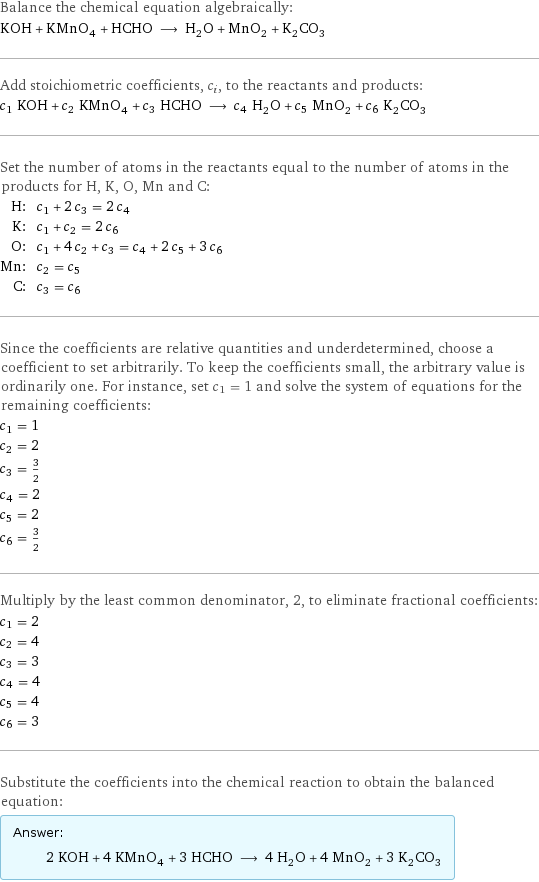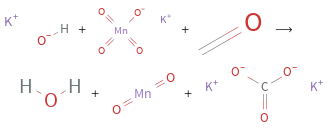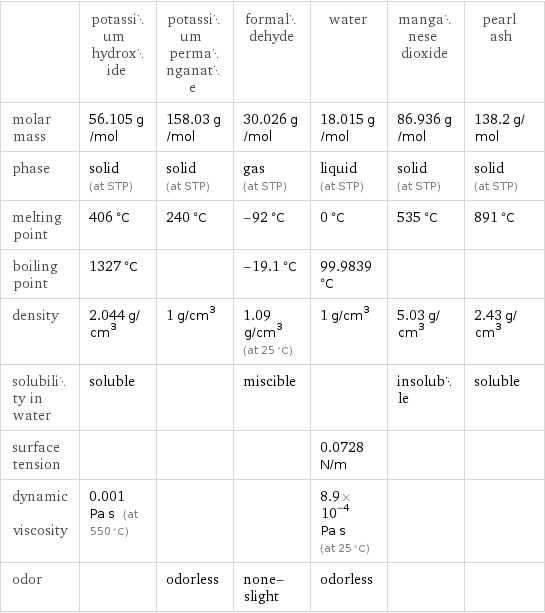Input interpretation

KOH potassium hydroxide + KMnO_4 potassium permanganate + HCHO formaldehyde ⟶ H_2O water + MnO_2 manganese dioxide + K_2CO_3 pearl ash
Balanced equation

Balance the chemical equation algebraically: KOH + KMnO_4 + HCHO ⟶ H_2O + MnO_2 + K_2CO_3 Add stoichiometric coefficients, c_i, to the reactants and products: c_1 KOH + c_2 KMnO_4 + c_3 HCHO ⟶ c_4 H_2O + c_5 MnO_2 + c_6 K_2CO_3 Set the number of atoms in the reactants equal to the number of atoms in the products for H, K, O, Mn and C: H: | c_1 + 2 c_3 = 2 c_4 K: | c_1 + c_2 = 2 c_6 O: | c_1 + 4 c_2 + c_3 = c_4 + 2 c_5 + 3 c_6 Mn: | c_2 = c_5 C: | c_3 = c_6 Since the coefficients are relative quantities and underdetermined, choose a coefficient to set arbitrarily. To keep the coefficients small, the arbitrary value is ordinarily one. For instance, set c_1 = 1 and solve the system of equations for the remaining coefficients: c_1 = 1 c_2 = 2 c_3 = 3/2 c_4 = 2 c_5 = 2 c_6 = 3/2 Multiply by the least common denominator, 2, to eliminate fractional coefficients: c_1 = 2 c_2 = 4 c_3 = 3 c_4 = 4 c_5 = 4 c_6 = 3 Substitute the coefficients into the chemical reaction to obtain the balanced equation: Answer: | | 2 KOH + 4 KMnO_4 + 3 HCHO ⟶ 4 H_2O + 4 MnO_2 + 3 K_2CO_3
Structures

+ + ⟶ + +
Names

potassium hydroxide + potassium permanganate + formaldehyde ⟶ water + manganese dioxide + pearl ash
Reaction thermodynamics
Gibbs free energy

| potassium hydroxide | potassium permanganate | formaldehyde | water | manganese dioxide | pearl ash molecular free energy | -379.4 kJ/mol | -737.6 kJ/mol | -102.5 kJ/mol | -237.1 kJ/mol | -465.1 kJ/mol | -1064 kJ/mol total free energy | -758.8 kJ/mol | -2950 kJ/mol | -307.5 kJ/mol | -948.4 kJ/mol | -1860 kJ/mol | -3191 kJ/mol | G_initial = -4017 kJ/mol | | | G_final = -5999 kJ/mol | | ΔG_rxn^0 | -5999 kJ/mol - -4017 kJ/mol = -1983 kJ/mol (exergonic) | | | | |
Equilibrium constant
![Construct the equilibrium constant, K, expression for: KOH + KMnO_4 + HCHO ⟶ H_2O + MnO_2 + K_2CO_3 Plan: • Balance the chemical equation. • Determine the stoichiometric numbers. • Assemble the activity expression for each chemical species. • Use the activity expressions to build the equilibrium constant expression. Write the balanced chemical equation: 2 KOH + 4 KMnO_4 + 3 HCHO ⟶ 4 H_2O + 4 MnO_2 + 3 K_2CO_3 Assign stoichiometric numbers, ν_i, using the stoichiometric coefficients, c_i, from the balanced chemical equation in the following manner: ν_i = -c_i for reactants and ν_i = c_i for products: chemical species | c_i | ν_i KOH | 2 | -2 KMnO_4 | 4 | -4 HCHO | 3 | -3 H_2O | 4 | 4 MnO_2 | 4 | 4 K_2CO_3 | 3 | 3 Assemble the activity expressions accounting for the state of matter and ν_i: chemical species | c_i | ν_i | activity expression KOH | 2 | -2 | ([KOH])^(-2) KMnO_4 | 4 | -4 | ([KMnO4])^(-4) HCHO | 3 | -3 | ([HCHO])^(-3) H_2O | 4 | 4 | ([H2O])^4 MnO_2 | 4 | 4 | ([MnO2])^4 K_2CO_3 | 3 | 3 | ([K2CO3])^3 The equilibrium constant symbol in the concentration basis is: K_c Mulitply the activity expressions to arrive at the K_c expression: Answer: | | K_c = ([KOH])^(-2) ([KMnO4])^(-4) ([HCHO])^(-3) ([H2O])^4 ([MnO2])^4 ([K2CO3])^3 = (([H2O])^4 ([MnO2])^4 ([K2CO3])^3)/(([KOH])^2 ([KMnO4])^4 ([HCHO])^3)](../image_source/bf49ce64e17672938813ab4bc02d6e3d.png)
Construct the equilibrium constant, K, expression for: KOH + KMnO_4 + HCHO ⟶ H_2O + MnO_2 + K_2CO_3 Plan: • Balance the chemical equation. • Determine the stoichiometric numbers. • Assemble the activity expression for each chemical species. • Use the activity expressions to build the equilibrium constant expression. Write the balanced chemical equation: 2 KOH + 4 KMnO_4 + 3 HCHO ⟶ 4 H_2O + 4 MnO_2 + 3 K_2CO_3 Assign stoichiometric numbers, ν_i, using the stoichiometric coefficients, c_i, from the balanced chemical equation in the following manner: ν_i = -c_i for reactants and ν_i = c_i for products: chemical species | c_i | ν_i KOH | 2 | -2 KMnO_4 | 4 | -4 HCHO | 3 | -3 H_2O | 4 | 4 MnO_2 | 4 | 4 K_2CO_3 | 3 | 3 Assemble the activity expressions accounting for the state of matter and ν_i: chemical species | c_i | ν_i | activity expression KOH | 2 | -2 | ([KOH])^(-2) KMnO_4 | 4 | -4 | ([KMnO4])^(-4) HCHO | 3 | -3 | ([HCHO])^(-3) H_2O | 4 | 4 | ([H2O])^4 MnO_2 | 4 | 4 | ([MnO2])^4 K_2CO_3 | 3 | 3 | ([K2CO3])^3 The equilibrium constant symbol in the concentration basis is: K_c Mulitply the activity expressions to arrive at the K_c expression: Answer: | | K_c = ([KOH])^(-2) ([KMnO4])^(-4) ([HCHO])^(-3) ([H2O])^4 ([MnO2])^4 ([K2CO3])^3 = (([H2O])^4 ([MnO2])^4 ([K2CO3])^3)/(([KOH])^2 ([KMnO4])^4 ([HCHO])^3)
Rate of reaction
![Construct the rate of reaction expression for: KOH + KMnO_4 + HCHO ⟶ H_2O + MnO_2 + K_2CO_3 Plan: • Balance the chemical equation. • Determine the stoichiometric numbers. • Assemble the rate term for each chemical species. • Write the rate of reaction expression. Write the balanced chemical equation: 2 KOH + 4 KMnO_4 + 3 HCHO ⟶ 4 H_2O + 4 MnO_2 + 3 K_2CO_3 Assign stoichiometric numbers, ν_i, using the stoichiometric coefficients, c_i, from the balanced chemical equation in the following manner: ν_i = -c_i for reactants and ν_i = c_i for products: chemical species | c_i | ν_i KOH | 2 | -2 KMnO_4 | 4 | -4 HCHO | 3 | -3 H_2O | 4 | 4 MnO_2 | 4 | 4 K_2CO_3 | 3 | 3 The rate term for each chemical species, B_i, is 1/ν_i(Δ[B_i])/(Δt) where [B_i] is the amount concentration and t is time: chemical species | c_i | ν_i | rate term KOH | 2 | -2 | -1/2 (Δ[KOH])/(Δt) KMnO_4 | 4 | -4 | -1/4 (Δ[KMnO4])/(Δt) HCHO | 3 | -3 | -1/3 (Δ[HCHO])/(Δt) H_2O | 4 | 4 | 1/4 (Δ[H2O])/(Δt) MnO_2 | 4 | 4 | 1/4 (Δ[MnO2])/(Δt) K_2CO_3 | 3 | 3 | 1/3 (Δ[K2CO3])/(Δt) (for infinitesimal rate of change, replace Δ with d) Set the rate terms equal to each other to arrive at the rate expression: Answer: | | rate = -1/2 (Δ[KOH])/(Δt) = -1/4 (Δ[KMnO4])/(Δt) = -1/3 (Δ[HCHO])/(Δt) = 1/4 (Δ[H2O])/(Δt) = 1/4 (Δ[MnO2])/(Δt) = 1/3 (Δ[K2CO3])/(Δt) (assuming constant volume and no accumulation of intermediates or side products)](../image_source/249663c8c8219e6f35df99df848ce0b5.png)
Construct the rate of reaction expression for: KOH + KMnO_4 + HCHO ⟶ H_2O + MnO_2 + K_2CO_3 Plan: • Balance the chemical equation. • Determine the stoichiometric numbers. • Assemble the rate term for each chemical species. • Write the rate of reaction expression. Write the balanced chemical equation: 2 KOH + 4 KMnO_4 + 3 HCHO ⟶ 4 H_2O + 4 MnO_2 + 3 K_2CO_3 Assign stoichiometric numbers, ν_i, using the stoichiometric coefficients, c_i, from the balanced chemical equation in the following manner: ν_i = -c_i for reactants and ν_i = c_i for products: chemical species | c_i | ν_i KOH | 2 | -2 KMnO_4 | 4 | -4 HCHO | 3 | -3 H_2O | 4 | 4 MnO_2 | 4 | 4 K_2CO_3 | 3 | 3 The rate term for each chemical species, B_i, is 1/ν_i(Δ[B_i])/(Δt) where [B_i] is the amount concentration and t is time: chemical species | c_i | ν_i | rate term KOH | 2 | -2 | -1/2 (Δ[KOH])/(Δt) KMnO_4 | 4 | -4 | -1/4 (Δ[KMnO4])/(Δt) HCHO | 3 | -3 | -1/3 (Δ[HCHO])/(Δt) H_2O | 4 | 4 | 1/4 (Δ[H2O])/(Δt) MnO_2 | 4 | 4 | 1/4 (Δ[MnO2])/(Δt) K_2CO_3 | 3 | 3 | 1/3 (Δ[K2CO3])/(Δt) (for infinitesimal rate of change, replace Δ with d) Set the rate terms equal to each other to arrive at the rate expression: Answer: | | rate = -1/2 (Δ[KOH])/(Δt) = -1/4 (Δ[KMnO4])/(Δt) = -1/3 (Δ[HCHO])/(Δt) = 1/4 (Δ[H2O])/(Δt) = 1/4 (Δ[MnO2])/(Δt) = 1/3 (Δ[K2CO3])/(Δt) (assuming constant volume and no accumulation of intermediates or side products)
Chemical names and formulas

| potassium hydroxide | potassium permanganate | formaldehyde | water | manganese dioxide | pearl ash formula | KOH | KMnO_4 | HCHO | H_2O | MnO_2 | K_2CO_3 Hill formula | HKO | KMnO_4 | CH_2O | H_2O | MnO_2 | CK_2O_3 name | potassium hydroxide | potassium permanganate | formaldehyde | water | manganese dioxide | pearl ash IUPAC name | potassium hydroxide | potassium permanganate | formaldehyde | water | dioxomanganese | dipotassium carbonate
Substance properties

| potassium hydroxide | potassium permanganate | formaldehyde | water | manganese dioxide | pearl ash molar mass | 56.105 g/mol | 158.03 g/mol | 30.026 g/mol | 18.015 g/mol | 86.936 g/mol | 138.2 g/mol phase | solid (at STP) | solid (at STP) | gas (at STP) | liquid (at STP) | solid (at STP) | solid (at STP) melting point | 406 °C | 240 °C | -92 °C | 0 °C | 535 °C | 891 °C boiling point | 1327 °C | | -19.1 °C | 99.9839 °C | | density | 2.044 g/cm^3 | 1 g/cm^3 | 1.09 g/cm^3 (at 25 °C) | 1 g/cm^3 | 5.03 g/cm^3 | 2.43 g/cm^3 solubility in water | soluble | | miscible | | insoluble | soluble surface tension | | | | 0.0728 N/m | | dynamic viscosity | 0.001 Pa s (at 550 °C) | | | 8.9×10^-4 Pa s (at 25 °C) | | odor | | odorless | none-slight | odorless | |
Units
